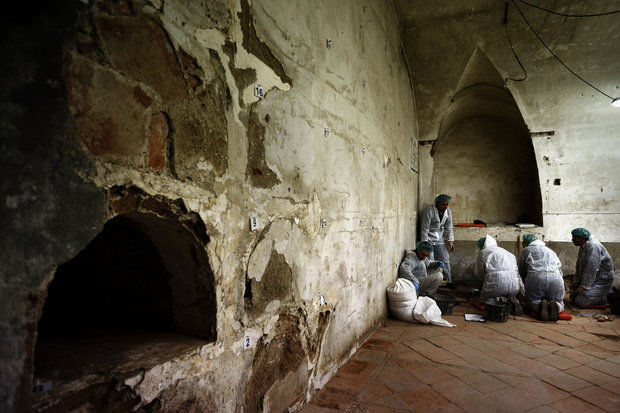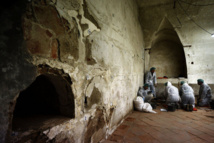"Remains of caskets were found, wood, rocks, some bone fragments, and indeed one of the fragments of a board of one of the caskets had the letters 'M.C.' formed in tacks," forensic anthropologist Francisco Etxeberria, who is leading the search, told a news conference.
Cervantes is recorded as having been buried at the convent's chapel in the centre of the Spanish capital a day after his April 22, 1616 death -- the same week that William Shakespeare died -- but the exact whereabouts of his grave are unknown.
Etxeberria's team launched in April 2014 what is the first significant search for the remains of the greatest writer of the Spanish Golden Age.
Using infrared cameras, 3D scanners and ground-penetrating radar, they identified 33 alcoves where bones could be stored.
They resumed their search on Saturday after a break of several months to probe the alcoves.
Researchers will now have to examine the bones to try to determine if Cervantes' are among them. Etxeberria cautioned the search was far from over.
"These two letters could be very interesting" but "from an anthropological point of view, we have not made any advances," he said.
Researchers will rely on war injuries suffered by Cervantes to help them identify the remains.
Cervantes was shot twice in the chest and once in his left hand during a 1571 naval conflict, the Battle of Lepanto, in which the Holy League led by Spain defeated the Ottoman fleet. His bones would still show signs of the injury.
If the remains do belong to Cervantes they would remain buried in the convent, which is still inhabited by nuns and has been designated part of Madrid's cultural heritage since 1921.
Born near Madrid in 1547, Cervantes has been dubbed the father of the modern novel for "The Ingenious Gentleman Don Quixote of La Mancha", published in two parts in 1605 and 1615.
His influence on the Spanish language has been so great that the language is often referred to as "the language of Cervantes".
--------------------------------------------------------------------------------------------------------
Cervantes is recorded as having been buried at the convent's chapel in the centre of the Spanish capital a day after his April 22, 1616 death -- the same week that William Shakespeare died -- but the exact whereabouts of his grave are unknown.
Etxeberria's team launched in April 2014 what is the first significant search for the remains of the greatest writer of the Spanish Golden Age.
Using infrared cameras, 3D scanners and ground-penetrating radar, they identified 33 alcoves where bones could be stored.
They resumed their search on Saturday after a break of several months to probe the alcoves.
Researchers will now have to examine the bones to try to determine if Cervantes' are among them. Etxeberria cautioned the search was far from over.
"These two letters could be very interesting" but "from an anthropological point of view, we have not made any advances," he said.
Researchers will rely on war injuries suffered by Cervantes to help them identify the remains.
Cervantes was shot twice in the chest and once in his left hand during a 1571 naval conflict, the Battle of Lepanto, in which the Holy League led by Spain defeated the Ottoman fleet. His bones would still show signs of the injury.
If the remains do belong to Cervantes they would remain buried in the convent, which is still inhabited by nuns and has been designated part of Madrid's cultural heritage since 1921.
Born near Madrid in 1547, Cervantes has been dubbed the father of the modern novel for "The Ingenious Gentleman Don Quixote of La Mancha", published in two parts in 1605 and 1615.
His influence on the Spanish language has been so great that the language is often referred to as "the language of Cervantes".
--------------------------------------------------------------------------------------------------------









 Home
Home Politics
Politics











